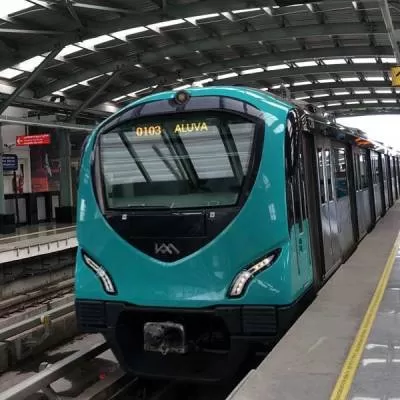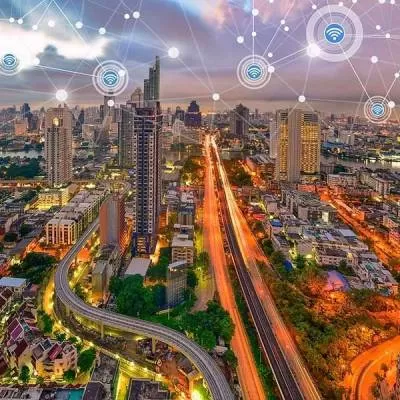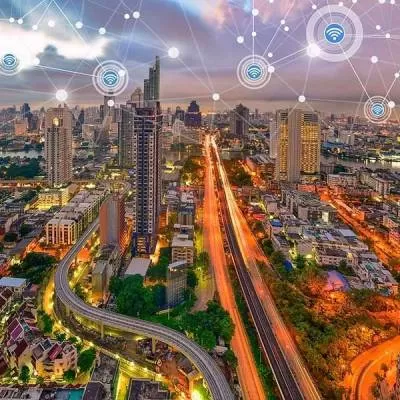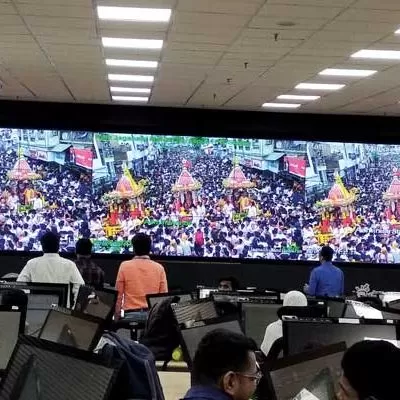- Home
- Infrastructure Urban
- SMART CITIES
- Smart Solutions for Smart Cities

Smart Solutions for Smart Cities
Cities today are motivated by their need to drive economic growth, increase investment and job creation, allowing for better standards of living, and the financial capability to manage the city infrastructure that serves the wider urban environment. Urbanisation and the effects of climate change place increasing burdens on the infrastructure systems and businesses that operate in cities.
In emerging economies, infrastructure cannot be built quick enough to keep pace with economic and urban development, while in developed economies, many infrastructure systems are ageing and in need of repair. Often, they have not been designed to cope with the population and lifestyles they must now support. Infrastructure operators and enterprises are looking for ways to optimise their infrastructure economically and quickly in order to remain competitive.
Urban transformation
All cities must strike a balance between three fundamental goals: Quality of life, economic competitiveness, and environmental protection. Cities that reach this equilibrium will be fit to address the challenges they face and can look forward to a more sustainable future.
´Smart cities´ are broadly nothing but a resultant of intelligently addressing and integrating four core pillars for sustainable urban transformation: Integrated and multimodal mobility; reliable power; secure and smart buildings, and clean environment.
Game-changers
IT and automation help reap the full potential of both existing and new urban infrastructure systems by enabling:
The result: We can make better use of existing infrastructure, increase efficiency, reduce operation costs, improve safety and resiliency as well as reduce environmental burdens. Also, delivering urban infrastructure swiftly and economically requires a clear, well formulated vision of city growth and economic prosperity, underpinned by a set of well-defined strategic objectives and initiatives. It must guide development across the necessary range of critical infrastructure according to clearly articulated priorities. This vision must be owned by key stakeholders´politicians, businesses and residents.
Future planning
Cities need to show strong leadership in developing and selling their city vision. The most successful cities recognise that they operate in a globally connected marketplace, competing with, and yet also depending on, other cities. These changing times also mean that city authorities can no longer plan for what is known today´they also need to plan to meet the needs of future generations. The rate of growth is so great in some parts of the world that cities can no longer take 20 years to deliver single-point interventions. Planning needs to be swift and cities need to be agile in response to changing circumstances and investors´ needs.
If all stakeholders like technology providers, decision-makers, urban developers and planners rigorously adopt environment-friendly technologies, they can achieve a viable balance between growth and the optimal use of resources. It´s time to take advantage of rapid technological advances to make Indian cities world-class, offering the best quality of life to citizens.
Smartening cities
Technology holds the answer to many urban challenges. Infrastructure operators, both public and private, can optimise their infrastructure economically and quickly in order to remain competitive. Through IT and automation, Siemens helps customers reap the full potential of urban infrastructure: Better use of existing infrastructure, increase in efficiency, reduction in operation costs, improvement in safety and resiliency as well as reduction of environmental burdens.
Advanced technological processes in automation already contain the intelligence required to automate processes and improve efficiencies but because of their ability to collect and communicate data, they offer opportunities for further optimisation with the addition of IT in the upper layers. For instance, field devices like sensors in roads, buildings, trains, power, gas and water grids can monitor and measure conditions and performance as well as collect data on external factors that could have an impact performance.
Through the application of advanced software such as data analysis and intelligent algorithms, this data can be interpreted and understood, and a corresponding action initiated. The result is that many processes and systems can be further automated to enhance performance and reduce operating costs.
The application of data analysis also enables infrastructure operators to take informed decisions or actions that can optimise performance. It becomes possible to predict patterns and forecast outcomes and this leads to better planning. IT also enables the integration of platforms to allow for a holistic view for a more efficient deployment of resources and to optimise links between systems.
Solutions from Siemens
Siemens offers solutions where IT and automation can optimise the performance of infrastructure systems:
PPP models
Nearly all cities across the globe have limited access to funds and ways of financing their plans.
With public-private sector collaboration being one of the most effective approaches to major infrastructure delivery today, cities have to operate differently and change their approach. Cities need to demonstrate visibly how infrastructure will deliver value to both users and investors. City authorities therefore have to work harder to understand the private-sector approach to doing business. Certainty, policy and legal regulation and long-term planning are essential to attract investments and create joint working approaches.
Cities are also now more reliant than ever before on private-sector support to scope, finance and deliver projects so much so that in the Twelfth Five-Year Plan, as much as 40 per cent of investments are expected from private-sector participation.
Supporting government initiatives
The flagship project of the Government of India to build 100 smart cities has received a firm financial allocation of Rs 7,060 crore in FY 2014-15. Also FDI norms have been relaxed to attract investors to build them.
Providing cities with the best solutions is a strategically important task for us. Siemens, the world´s largest engineering company, provides innovative solutions to help tackle the world´s major challenges across key sectors. It is a global powerhouse in electronics and electrical engineering, providing infrastructure solutions, primarily for cities and metropolitan areas. I am confident that Siemens will be involved with these smart cities in some form or the other.

Further Read:
The August 2014 edition Cover Story of the CW PROPERTY TODAY section in CW has extensively covered Smart Cities, throwing up new windows of opportunity for the municipal government, technology companies, consultants, service providers and citizens. Click here to read on...
- IT
- Automation
- Tilak Raj Seth
- Siemens Ltd
- Infrastructure
- Cities
- Urbanisation
- Transformation
- Smart Cities
- Reliable Power
- Secure
- Smart Buildings
- Costs
- Technology Providers
- Decision-Makers
- Urban Developers
- Planners
- Technology
- Urban Challenges. Infrastructure Operators,Roads
- Buildings
- Trains
- Power
- Gas
- Water Grids
- Energy
- Building Controls
- Heating
- Lighting
- Air-Conditioning
- Si
IT and automation can help reap the full potential of existing and new urban infrastructure systems, writes TILAK RAJ SETH, Executive Vice-President, Infrastructure & Cities Sector, Siemens Ltd. Cities today are motivated by their need to drive economic growth, increase investment and job creation, allowing for better standards of living, and the financial capability to manage the city infrastructure that serves the wider urban environment. Urbanisation and the effects of climate change place increasing burdens on the infrastructure systems and businesses that operate in cities. In emerging economies, infrastructure cannot be built quick enough to keep pace with economic and urban development, while in developed economies, many infrastructure systems are ageing and in need of repair. Often, they have not been designed to cope with the population and lifestyles they must now support. Infrastructure operators and enterprises are looking for ways to optimise their infrastructure economically and quickly in order to remain competitive. Urban transformation All cities must strike a balance between three fundamental goals: Quality of life, economic competitiveness, and environmental protection. Cities that reach this equilibrium will be fit to address the challenges they face and can look forward to a more sustainable future. ´Smart cities´ are broadly nothing but a resultant of intelligently addressing and integrating four core pillars for sustainable urban transformation: Integrated and multimodal mobility; reliable power; secure and smart buildings, and clean environment. Game-changers IT and automation help reap the full potential of both existing and new urban infrastructure systems by enabling: Increased intelligence and transparency by providing the right information at the right time to make informed decisions Integration so that information can be shared across systems and organisations to eliminate silos and optimise performance Automated processes to boost efficiency and reduce costs. The result: We can make better use of existing infrastructure, increase efficiency, reduce operation costs, improve safety and resiliency as well as reduce environmental burdens. Also, delivering urban infrastructure swiftly and economically requires a clear, well formulated vision of city growth and economic prosperity, underpinned by a set of well-defined strategic objectives and initiatives. It must guide development across the necessary range of critical infrastructure according to clearly articulated priorities. This vision must be owned by key stakeholders´politicians, businesses and residents. Future planning Cities need to show strong leadership in developing and selling their city vision. The most successful cities recognise that they operate in a globally connected marketplace, competing with, and yet also depending on, other cities. These changing times also mean that city authorities can no longer plan for what is known today´they also need to plan to meet the needs of future generations. The rate of growth is so great in some parts of the world that cities can no longer take 20 years to deliver single-point interventions. Planning needs to be swift and cities need to be agile in response to changing circumstances and investors´ needs. If all stakeholders like technology providers, decision-makers, urban developers and planners rigorously adopt environment-friendly technologies, they can achieve a viable balance between growth and the optimal use of resources. It´s time to take advantage of rapid technological advances to make Indian cities world-class, offering the best quality of life to citizens. Smartening cities Technology holds the answer to many urban challenges. Infrastructure operators, both public and private, can optimise their infrastructure economically and quickly in order to remain competitive. Through IT and automation, Siemens helps customers reap the full potential of urban infrastructure: Better use of existing infrastructure, increase in efficiency, reduction in operation costs, improvement in safety and resiliency as well as reduction of environmental burdens. Advanced technological processes in automation already contain the intelligence required to automate processes and improve efficiencies but because of their ability to collect and communicate data, they offer opportunities for further optimisation with the addition of IT in the upper layers. For instance, field devices like sensors in roads, buildings, trains, power, gas and water grids can monitor and measure conditions and performance as well as collect data on external factors that could have an impact performance. Through the application of advanced software such as data analysis and intelligent algorithms, this data can be interpreted and understood, and a corresponding action initiated. The result is that many processes and systems can be further automated to enhance performance and reduce operating costs. The application of data analysis also enables infrastructure operators to take informed decisions or actions that can optimise performance. It becomes possible to predict patterns and forecast outcomes and this leads to better planning. IT also enables the integration of platforms to allow for a holistic view for a more efficient deployment of resources and to optimise links between systems. Solutions from Siemens Siemens offers solutions where IT and automation can optimise the performance of infrastructure systems: Desigo: Building controls adjust heating and lighting based on a range of parameters such as occupancy and levels of daylight to reduce energy consumption by up to 30 per cent. Autonomous systems such as ventilation, heating, air-conditioning, lighting, safety and security can be integrated into one system for more efficient operation. Smart Grid Suite: In a smart grid, intelligent devices protect power lines, ensure power quality and measure power consumption. Data generated by these devices combined with IT applications allow complex grid balancing, including load management, forecasting and trading. Siveillance: Video analytics in surveillance systems can identify incidents and automatically raise an alert. This avoids the risk of human error and enables a faster response in the event of an emergency. Railbam: An acoustic monitoring system can detect damage in the wheel sets of trains before a failure occurs, improving both safety and maintenance costs. Trainguard: Train automation allows the distance between trains to be safely reduced to increase frequency and capacity, and cope with increasing passenger volumes. Sitraffic: Intelligent traffic management systems integrate data from numerous sources such as signal controllers, sensors measuring traffic volume and speed and public transport sources to manage traffic more effectively and provide real-time to travellers so they can choose when and how to travel. PPP models Nearly all cities across the globe have limited access to funds and ways of financing their plans. With public-private sector collaboration being one of the most effective approaches to major infrastructure delivery today, cities have to operate differently and change their approach. Cities need to demonstrate visibly how infrastructure will deliver value to both users and investors. City authorities therefore have to work harder to understand the private-sector approach to doing business. Certainty, policy and legal regulation and long-term planning are essential to attract investments and create joint working approaches. Cities are also now more reliant than ever before on private-sector support to scope, finance and deliver projects so much so that in the Twelfth Five-Year Plan, as much as 40 per cent of investments are expected from private-sector participation. Supporting government initiatives The flagship project of the Government of India to build 100 smart cities has received a firm financial allocation of Rs 7,060 crore in FY 2014-15. Also FDI norms have been relaxed to attract investors to build them. Providing cities with the best solutions is a strategically important task for us. Siemens, the world´s largest engineering company, provides innovative solutions to help tackle the world´s major challenges across key sectors. It is a global powerhouse in electronics and electrical engineering, providing infrastructure solutions, primarily for cities and metropolitan areas. I am confident that Siemens will be involved with these smart cities in some form or the other. Further Read: The August 2014 edition Cover Story of the CW PROPERTY TODAY section in CW has extensively covered Smart Cities, throwing up new windows of opportunity for the municipal government, technology companies, consultants, service providers and citizens. Click here to read on...
























